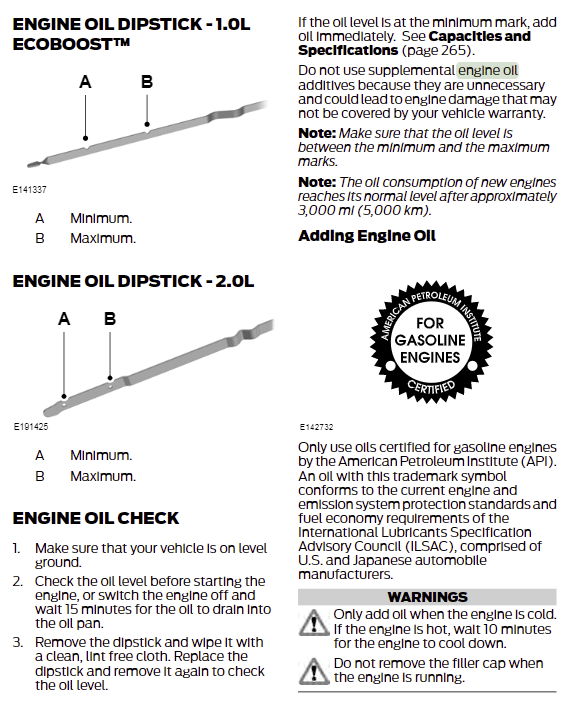Hey there, fellow car enthusiasts! Thomas is here, and today we’re going to talk about the fantastic 2016 Ford Focus. This little gem of a car has been a popular choice for many drivers thanks to its great fuel efficiency, stylish design, and impressive performance. Available in several different engine types, including the 1.0L EcoBoost, 2.0L Ti-VCT, 2.0L EcoBoost, and the 2.3L EcoBoost, there’s a Ford Focus for everyone!
Now, you might be wondering why I’m bringing up the topic of oil types. Well, let me tell you, using the right oil type for your 2016 Ford Focus is crucial to ensure your engine stays in tip-top shape. The wrong oil type can lead to reduced performance, increased wear and tear, and even costly engine damage. I’ve been a mechanic for over 20 years, and I’ve seen my fair share of engine troubles caused by improper oil usage. Trust me; you don’t want to go down that road.
In this article, I’ll be sharing my expert knowledge to help you choose the perfect oil type for your 2016 Ford Focus based on the manufacturer’s recommendations. We’ll also discuss the importance of oil viscosity, synthetic vs. conventional oils, and the role of the Intelligent Oil-Life Monitor in keeping your engine running smoothly. So, buckle up, and let’s dive right into the fascinating world of motor oils!
The Engine Specifications of the 2016 Ford Focus
The 2016 Ford Focus comes standard with a 2.0-liter four-cylinder engine that produces 160 horsepower. That engine is paired with either a five-speed manual or an available six-speed automated manual transmission. A 123-horsepower, turbocharged 1.0-liter three-cylinder engine is also available.

Alright, let’s talk about the engine options for the 2016 Ford Focus. These are the four engine types you can find under the hood:
- 1.0L EcoBoost.
This little turbocharged, 3-cylinder engine is perfect for those who are looking for a balance between fuel efficiency and power. It’s capable of delivering around 123 horsepower and 125 lb-ft of torque, making it a peppy choice for city driving. - 2.0L Ti-VCT.
The 2.0L Ti-VCT engine is a naturally aspirated, 4-cylinder option with 160 horsepower and 146 lb-ft of torque. This engine is a reliable choice for those who want a smooth and efficient ride without the need for turbocharging. - 2.0L EcoBoost (ST).
For those who crave a bit more power and performance, the 2.0L EcoBoost (ST) engine is the way to go. This turbocharged, 4-cylinder engine cranks out an impressive 252 horsepower and 270 lb-ft of torque, giving you a thrilling driving experience. - 2.3L EcoBoost (RS).
Last but certainly not least, we have the 2.3L EcoBoost (RS) engine. This high-performance, turbocharged 4-cylinder powerhouse pumps out a whopping 350 horsepower and 350 lb-ft of torque, making it the ultimate choice for speed enthusiasts and those who want the best performance Ford Focus has to offer.
Now that we’ve covered the available engines let’s discuss the power and performance. The 2016 Ford Focus offers a wide range of options to suit different driving preferences and needs. From the fuel-efficient 1.0L EcoBoost engine to the high-performance 2.3L EcoBoost (RS) engine, there’s a Ford Focus for everyone.
The 1.0L EcoBoost and 2.0L Ti-VCT engines provide a balance between fuel efficiency and power, making them ideal for daily commuting and city driving. On the other hand, the 2.0L EcoBoost (ST) and 2.3L EcoBoost (RS) engines are designed for those who crave exhilarating performance and a thrilling driving experience.
What Kind Of Oil Does A 2016 Ford Focus Take?
Now that we’ve covered the engine types, let’s talk about the best oil for each of them. Ford has specific recommendations for each engine, and it’s essential to stick to these guidelines to keep your engine running like a well-oiled machine.
- Motorcraft SAE 5W-20 Premium Synthetic Blend Motor Oil for 1.0L EcoBoost and 2.0L Ti-VCT engines:
A. 4.3 qt (4.1 L) capacity for 1.0L EcoBoost with filter change;
B. 4.5 qt (4.3 L) capacity for 2.0L Ti-VCT with filter change
For both the 1.0L EcoBoost and the 2.0L Ti-VCT engines, Ford recommends Motorcraft SAE 5W-20 Premium Synthetic Blend Motor Oil. This oil provides excellent protection and performance for these engines. Remember, when changing the oil and filter, the 1.0L EcoBoost requires 4.3 quarts (4.1 liters), while the 2.0L Ti-VCT needs 4.5 quarts (4.3 liters).
- SAE 5W-30 for 2.0L EcoBoost (ST) engines:
A. 5.7 qt (5.4 L) capacity with filter change.
For the more powerful 2.0L EcoBoost (ST) engine, Ford recommends using SAE 5W-30 motor oil. When performing an oil and filter change, you’ll need 5.7 quarts (5.4 liters) of oil for this engine.
- SAE 5W-50 for 2.3L EcoBoost (RS) engines:
A. 5.7 qt (5.4 L) capacity with filter change
For the high-performance 2.3L EcoBoost (RS) engine, Ford suggests using SAE 5W-50 motor oil. Like the 2.0L EcoBoost (ST), this engine also requires 5.7 quarts (5.4 liters) of oil when changing the oil and filter.
While Ford recommends Motorcraft motor oils, there are several other high-quality brands you can consider, such as:
- Mobil 1
- Castrol
- Pennzoil
- Valvoline
- Royal Purple
Regardless of the brand you choose, always make sure to select the oil with the correct viscosity and specifications recommended by Ford.
As a mechanic with over 20 years of experience, I can’t stress enough the importance of following the manufacturer’s guidelines when it comes to oil types and capacities. Using the right oil type and viscosity ensures optimal engine performance, prolongs engine life, and helps prevent costly repairs down the road. So, remember to always stick to the recommended oil type for your 2016 Ford Focus to keep your engine running smoothly and efficiently!
Oil Change Intervals and Maintenance
Intelligent Oil-Life Monitor
- Determines oil change intervals based on vehicle usage.
The 2016 Ford Focus comes equipped with an Intelligent Oil-Life Monitor that helps you determine when to change the engine oil based on your vehicle’s use. This smart system takes into account factors like driving conditions, temperature, and engine load to calculate the most accurate oil change intervals. - Displays oil change message in the information display.
When it’s time for an oil change, your Ford Focus will let you know by displaying a message on the information display. This makes it easy for you to keep up with regular maintenance and keep your engine in top condition.
Suggested oil change intervals
- Every 5,000 miles (8,000 km) or six months
As a general rule, it’s a good idea to change the engine oil and filter in your 2016 Ford Focus every 5,000 miles (8,000 km) or six months, whichever comes first. However, the actual oil change intervals will depend on your driving habits and the Intelligent Oil-Life Monitor’s calculations. - Factors affecting oil change frequency
Various factors, such as extreme temperatures, heavy loads, frequent short trips, and dusty conditions, can impact oil change frequency. In these cases, you might need to change the oil more frequently to maintain optimal engine performance and longevity.
When you change the engine oil, it’s also essential to replace the oil filter. A clean oil filter ensures that your engine oil remains free of contaminants, providing better protection and performance.
After changing the engine oil and filter, don’t forget to reset the Intelligent Oil-Life Monitor. This will allow the system to recalculate the next oil change interval based on your vehicle’s usage accurately.
It’s a good practice to regularly check your engine oil level and quality. Make sure to do this with the engine off and on level ground. If you notice the oil level is low, top it off with the recommended oil type. If the oil appears dirty or contaminated, it’s time for an oil change.

Signs of oil-related problems
Keep an eye out for signs of oil-related issues, such as:
- Low oil pressure warning light
- Oil leaks
- Burning oil smell
- Blue or white smoke from the exhaust
- Decreased fuel efficiency
If you experience any of these problems, it’s essential to address them promptly to prevent further engine damage. Consult a professional mechanic if you’re unsure how to handle the situation. Remember, regular oil changes and maintenance are the key to keeping your 2016 Ford Focus running smoothly and efficiently!
Understanding Motor Oil
Motor oil plays several vital roles in your engine:
- Lubrication: It forms a protective film between the moving parts of the engine, reducing friction, wear, and heat generation.
- Cooling: By circulating through the engine, motor oil helps dissipate heat from the engine components, preventing overheating.
- Cleaning: Motor oil contains detergents and dispersants that help clean the engine by removing contaminants and sludge.
- Sealing: Oil aids in sealing the gap between the piston rings and the cylinder walls, ensuring optimal compression and engine efficiency.
- Rust and corrosion protection: Motor oil contains additives that help protect engine components from rust and corrosion.
Oil Viscosity Explained
- Viscosity ratings
Viscosity refers to a fluid’s resistance to flow. In motor oil, it’s measured using the SAE (Society of Automotive Engineers) scale. The viscosity rating typically consists of two numbers separated by a “W” (e.g., 5W-20). The first number represents the oil’s cold temperature viscosity, while the second number indicates its viscosity at high temperatures. The lower the number, the thinner the oil and the more easily it flows. - Effects of viscosity on engine performance
Choosing the right viscosity is crucial for engine performance. Thinner oils flow more easily, providing better cold-start protection and reducing internal friction. Thicker oils, on the other hand, provide better high-temperature protection and maintain their viscosity under extreme conditions. Using the recommended viscosity for your 2016 Ford Focus is essential to ensure optimal engine performance and protection.
Synthetic vs. conventional oil
Synthetic oil is made from chemically modified compounds, while conventional oil is derived from crude petroleum. Here are the pros and cons of each type:
Synthetic oil:
Pros: Better low-temperature performance, improved high-temperature stability, reduced friction and wear, longer oil change intervals, and enhanced engine cleanliness.
Cons: More expensive than conventional oil.
Conventional oil:
Pros: Less expensive than synthetic oil.
Cons: Inferior low-temperature performance, shorter oil change intervals, and less protection against sludge and deposits.
Suitability for the 2016 Ford Focus
Ford recommends using Motorcraft SAE 5W-20 Premium Synthetic Blend Motor Oil for the 1.0L EcoBoost and 2.0L Ti-VCT engines, and SAE 5W-30 for the 2.0L EcoBoost (ST), and SAE 5W-50 for the 2.3L EcoBoost (RS) engines. Using a synthetic blend or full synthetic oil is suitable for the 2016 Ford Focus, as it provides better protection and performance than conventional oil. Always follow the manufacturer’s recommendations for oil type and viscosity to ensure optimal engine performance and longevity.
Conclusion
Selecting the correct oil type for your 2016 Ford Focus is crucial to maintaining optimal engine performance, reducing wear and tear, and prolonging the life of your vehicle. Using the recommended oil type and viscosity ensures that your engine is well-protected and functioning efficiently.
Regular oil changes and proper maintenance are key to keeping your 2016 Ford Focus running smoothly and efficiently. By following the manufacturer’s guidelines on oil types, viscosity ratings, and oil change intervals, you can help prevent costly repairs and extend the life of your engine.
Remember to monitor your engine’s oil level and quality regularly and to address any oil-related issues promptly. With proper care and attention, your 2016 Ford Focus will continue to serve you well for years to come.










